ALUMNI: BANKNOTE/PORTRAIT ARTIST
DAN DES EYNON
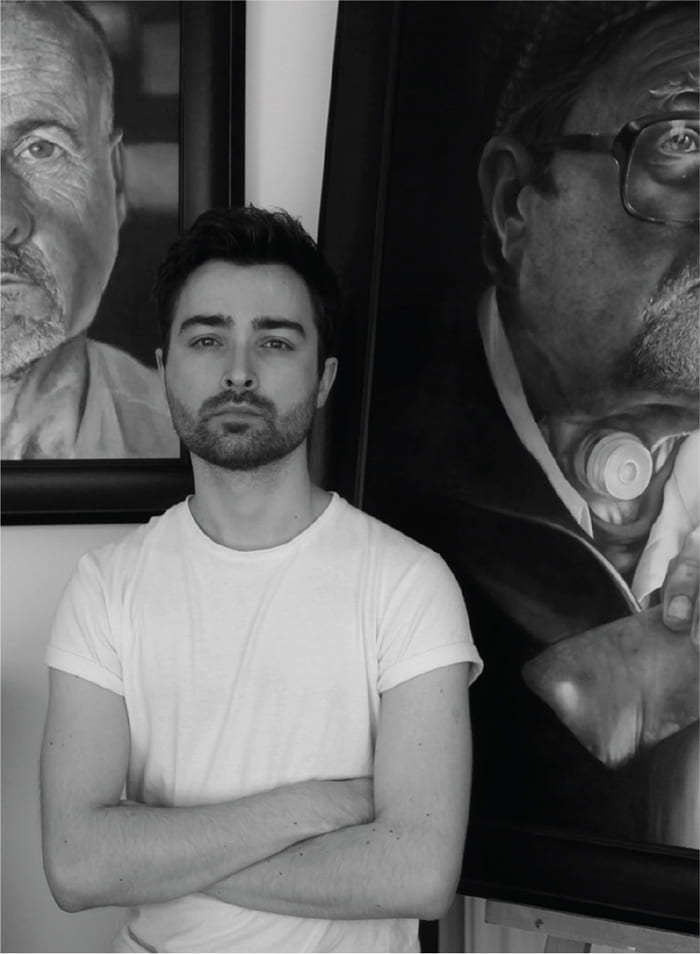
We talk to Dan about his training in illustration leading to an in-house role as a banknote artist, supported by freelance illustration and portraiture.
Q: Your creative journey has taken an extraordinary path. How did the opportunity to become a banknote artist come about? What has your experience been in this role so far?
I certainly didn’t think this is what I would be doing as my job! The banknote industry is almost a hidden world and I really didn’t know much about it beforehand. I was actually scouted and offered the job at the New Designers Graduate Exhibition in London at the end of my 3rd year at Falmouth. Over the past few years I’ve worked on an array of banknotes and passports for countries all around the world.
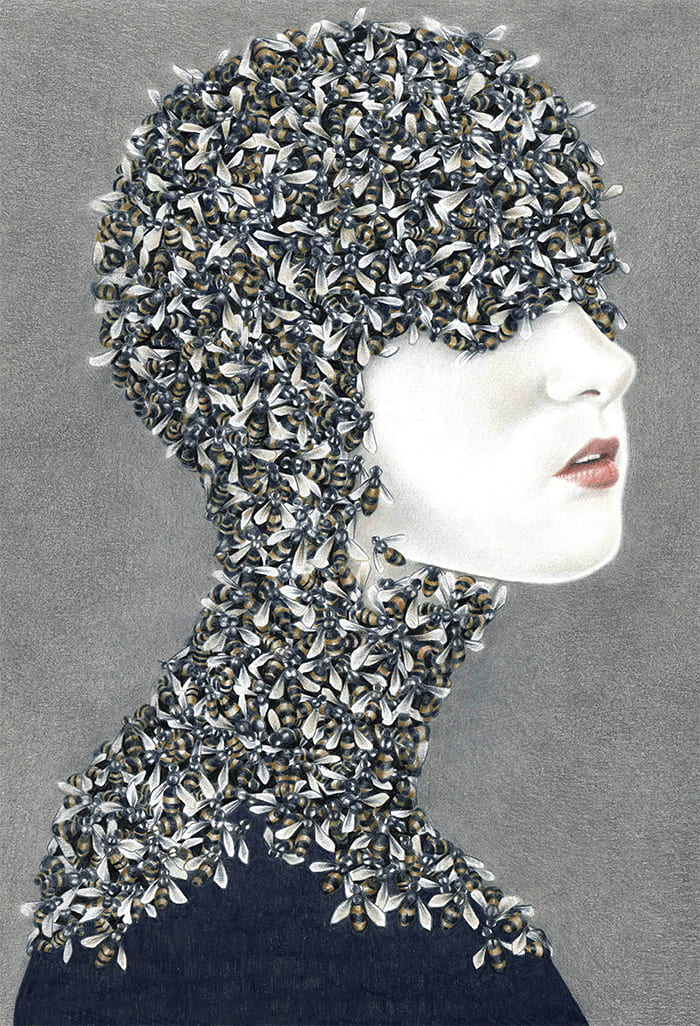 Personal Project, ‘Beekeeper II’. Promotional poster for the World Illustration Awards; selected for ‘American Illustration 37’
Personal Project, ‘Beekeeper II’. Promotional poster for the World Illustration Awards; selected for ‘American Illustration 37’
Q: When considering Illustration as a subject, we often think of contexts such as children’s books, posters, advertising and editorial work. It is easy to overlook the fact that drawn images also make their way into our wallets in the form of banknotes. As a banknote artist, do you still think of yourself as an Illustrator? Has your understanding of Illustration changed since starting this job?
I guess that’s true in many ways, people often think of currency purely for its monetary value, but it’s also one of the most prevalent and widely distributed platforms for artwork in the world. I also feel that there is a blurred line across many disciplines; the role of a banknote artist is inlaid with technique and precision, but there is definitely a craftsmanship and artistry behind what we are doing too.
Q: It is impressive that this craftmanship is still valued and that traditional methods are still being used today, especially as we live in an age where Digital Software is so prevalent. Why do you feel that this is preferred over the use of technology?
I think a lot of people are surprised that the artwork for banknotes is still drawn by hand, and traditionally the images would have been engraved onto copper or steel. Although our tools have changed, we still keep the same techniques, just replacing the engraving tool with pen and ink. There are computer capabilities available producing perfectly smooth and clean lines that at times can look sterile, so I feel there is something enriching about the inclusion of human error as it brings life to the work and makes it difficult to forge. As we work in an industry of security this is actually a key advantage.
I was lucky enough to be sent to Italy for 3 months, to an Engraving Academy where I learnt how to traditionally engrave onto copper, which gave me an understanding of the original techniques and the history of the craft. I think it is important to carry on teaching such draughtsmanship, but still have room for development too.
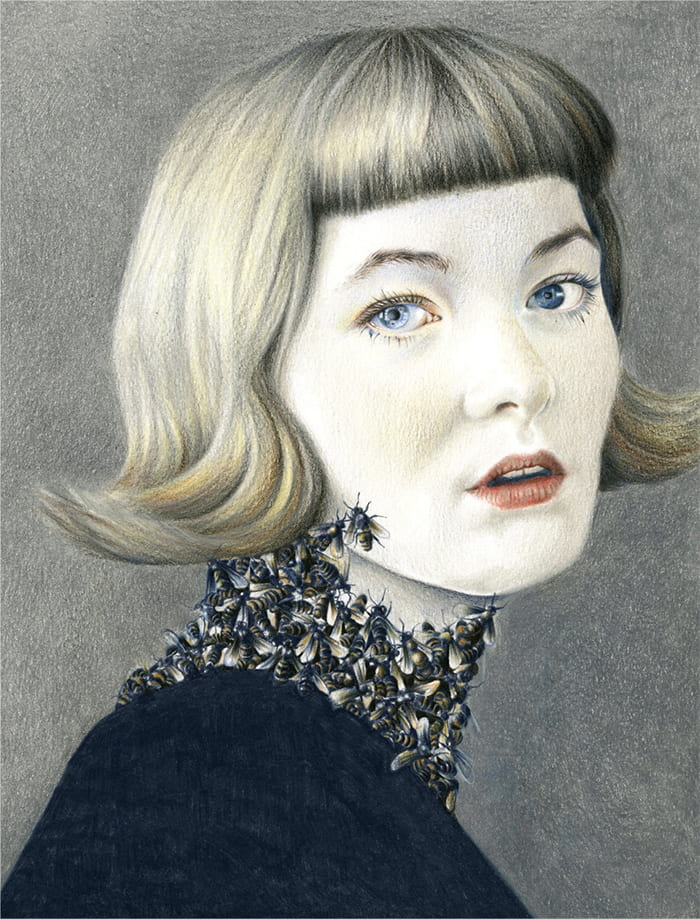 Personal Project, ‘Beekeeper I’. Winner of the Student Award, Cheltenham Illustration Awards
Personal Project, ‘Beekeeper I’. Winner of the Student Award, Cheltenham Illustration Awards
Q: When you begin a new project, how are you briefed? Are there rules or directions about how detailed and complex your work needs to be? Are you involved with any of the research, planning or ideas, and if so, do you use references?
The artwork for banknotes takes between 3-6 weeks to produce on average. If we’re lucky, we are given a high-quality reference, but at times the reference is very poor, so we will have to redraw the entire concept. We draw the image out in pencil first – everything is made up of lines and dots so it is easier to make adjustments at this stage. Once we are happy with the pencil work we ink it in, still making necessary adjustments throughout the process. There’s a restriction with how big you can draw the lines – if they are too big the ink will bleed during the printing production, but if they are too small, they just won’t print at all. We use a material called Kodatrace to work on and I usually work on a few sheets, looking at different approaches and line directions, which include main lines, crossings and interdots. At this stage, choosing which details to leave out is just as important as deciding what to put in. Too much information in an image can confuse the eye, and it can look muddy if there isn’t enough contrast. We also do litho work which is produced using stipple – this is more about overall tone rather than dot placement. It’s something I’ve always wanted to explore, so I’m thrilled to have had the opportunity to do so through this job.
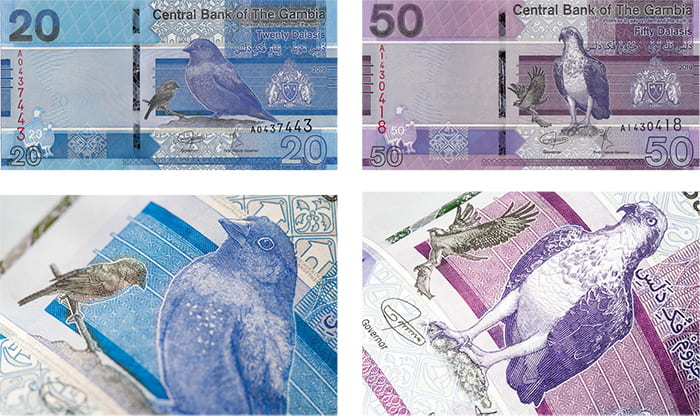 Series of banknote designs, 20 Dalasi and 50 Dalasi, The Gambia
Series of banknote designs, 20 Dalasi and 50 Dalasi, The Gambia
Q: Which banknotes have you illustrated so far, and for which countries? Are there any projects that you have enjoyed working on in particular?
Banknotes are often used as a window into a country, representing their past and present and sometimes projecting their future. Working on such projects has given me more awareness of different cultures and societies; so each project is a new learning experience, and each is enjoyable in different ways.
Some of my most memorable projects are:
Guernsey WWI Commemorative £20
Banknote Dominican Republic Passport
Ulster Ireland Banknote series £5, £10 and £20
Gambia Banknote series 10, 20, 50 and 100
Q: Can you tell us about the formal training you had to undertake for your role as a banknote illustrator. How long did this process take, and what did it involve?
My initial training period was two years, which included an array of live work. Throughout this period I covered a myriad of different subjects from buildings to animals – subjects that would give me a broad foundation of techniques which would equip me for future projects. My first training piece was literally to draw straight lines and circles freehand. Fundamentally everything consists of lines and dots and your work has to be clean and precise, so it was key to master these skills early on. I have since gone on to Portraiture, which is a discipline of its own! If you draw a leaf out of place no one’s really going to notice, but if you draw an eye in the wrong place I think a few people are going to pass comment!
Q: The role of a banknote illustrator is clearly a position of considerable responsibility; the skills you have developed are fundamental necessities. Were there any particular skills that you refined on your BA that you have been able to apply to this role?
Life drawing is something that I really loved at University, and I have carried that on since graduating. Core skills which have been fundamental to my practice include understanding light and dark, form and anatomy. I have continued to take atelier courses on traditional sight/size methods and sculpture courses, which have helped me understand facial contours and how I might work out line directions for a portrait. The Falmouth Illustration course helped me to learn the necessary discipline to meet deadlines and this is something that is extremely important when it comes to live jobs. I try to give myself extra time at the end of a project, as on a few occasions the deadline has been brought forward. Visual problem solving was a key part of my degree and I always maintain this by trialling different concepts before settling on a final piece.
“I was lucky enough to be sent to Italy for 3 months, to an Engraving Academy where I learnt how to traditionally engrave onto Copper, giving me an understanding of the original techniques and the history of the craft.”
Q: I imagine illustrating banknotes does not provide a huge amount of manoeuvrability in terms of creative freedom, although your wonderful imagination transpires across your personal projects and commissions. Your series of award winning ‘Beekeeper’ illustrations are particularly expressive and surreal. Do you feel that working to such specific briefs inspires you to be more innovative in other aspects of your practice?
I have developed three quite distinct veins of work: my painting, the banknote work and my illustration work. I feel that in each of these areas I use a different part of my brain! I guess my Illustrative work allows me to flex my more surreal side, which is balanced between being aesthetically delicate with an undertone of the macabre. The ‘Beekeeper’ series was initiated as a University project which explored the use of animals and insects as part of fashion garments. It started as a standalone piece of art but has since progressed into a larger series. The first ‘Beekeeper’ illustration won the Student Award at the Cheltenham Illustration Awards. The second piece, ‘Beekeeper II’, was used to promote the World Illustration Awards and was also selected the for the ‘American Illustration 37’ Book, which happened to be the first Illustration book I ever bought.
 Personal Project, painting ‘Trepidation’. Winner of the Art Gemini Prize, London.
Personal Project, painting ‘Trepidation’. Winner of the Art Gemini Prize, London.
Q: It is inspiring to hear that your work takes so many forms, with each strand of your practice being equally successful. Can you tell us about your oil painting? Has your experience of working on time consuming, technically challenging and highly accurate drawings helped to develop your abilities as a painter? Which area of your practice are you most passionate about?
Oil painting is probably the area I am most passionate about. My paintings are a real labour of love and have a more personal attachment. I have full control over what I want to portray, and each painting has a very distinct story, so I guess my paintings have become more of an emotional outlet. It was a real pivotal moment when I won first prize at the Art Gemini Prize in London, for the painting of my Dad. The one thing that my paintings allow is layer upon layer of mistakes, some of which I can choose to paint over and some of which I can decide to keep. The banknote work doesn’t often have the same manoeuvrability, so every line has to be somewhat planned and calculated. I find it amusing that my paintings and banknote engravings take around the same time to produce, but there is such a huge contrast in scale between the two, my paintings are large scale and my banknote engravings are very small, which are often best viewed under an eyeglass to appreciate the detail.
Q: Although your work varies in terms of context, there seems to be a common thread running through everything you do: there’s a strong focus on people. Can you describe what it is that compels you to illustrate the human form? Is it part of a larger curiosity to understand the nature of humanity, or to tell stories perhaps?
I’ve always gravitated towards figurative work. The face is almost like a landscape, where the subtly of tone and line can portray such contrasting emotions. My personal paintings are often more solemn, painted at a pinnacle moment in the sitter’s life. I often paint my family as I want to capture them fully and I think when you have such a personal relationship you can really identify the true essence of a person. This is what really compels me.
Q: As an Illustration student, how did you imagine your work would progress? Did you have an idea of the kinds of projects you would like to be involved in and has this vision changed at all?
I really wanted to develop my portfolio and my skill set after graduation, pursuing gallery work and making bigger paintings, whilst also expanding my illustration practice through print and publication. I have always been multidisciplinary, but I never expected that I would be creating the artwork for banknotes! My work has always been somewhat time consuming so I’m glad that I work in a field that embraces that.
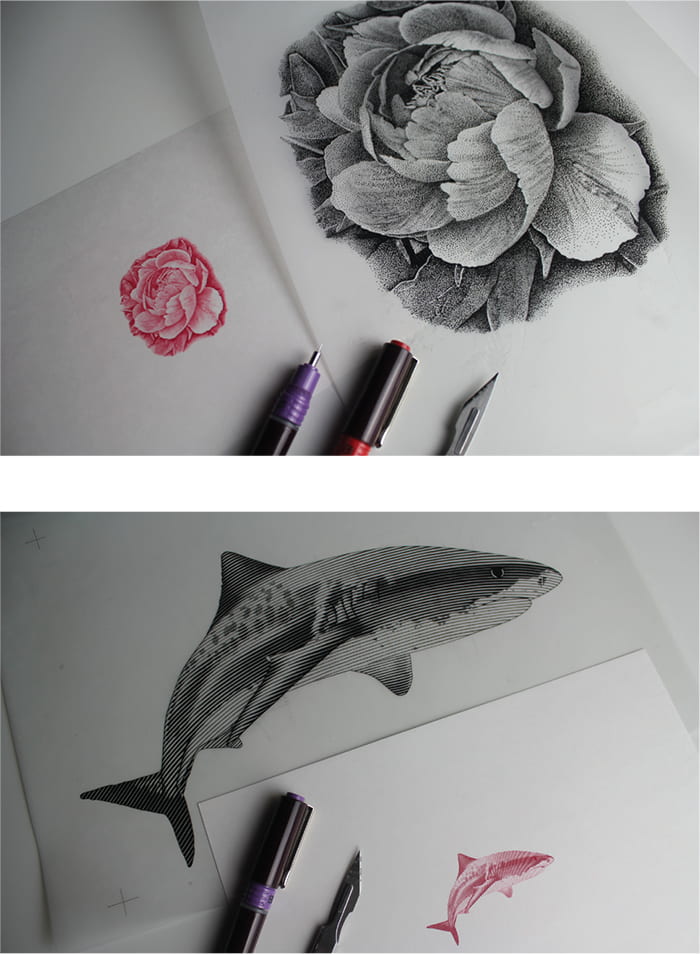 Top: Stipple and intaglio print, Bottom: Engraving and intaglio print
Top: Stipple and intaglio print, Bottom: Engraving and intaglio print
Q: Your Illustration practice has taken you on a unique and exciting path so far! How do you envisage the future? Are there any new creative ventures on the horizon?
I aim to continue developing my paintings. I recently exhibited at the Mall Galleries, which was one for the bucket list, but there are a few other London galleries I’d like to tick off the list too. I would really love to venture more into sculpture work, as it is an area that I have always admired and been fascinated by. I also have a few picture book ideas up my sleeve, so watch this space…

